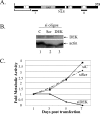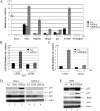Apoptosis inhibition by the human DEK oncoprotein involves interference with p53 functions
- PMID: 16894028
- PMCID: PMC1636856
- DOI: 10.1128/MCB.00430-06
Apoptosis inhibition by the human DEK oncoprotein involves interference with p53 functions
Abstract
The DEK proto-oncogene has been associated with human carcinogenesis-either as a fusion with the CAN nucleoporin protein or when transcriptionally upregulated. Mechanisms of intracellular DEK functions, however, have remained relatively unexplored. We have recently demonstrated that DEK expression is induced by the high-risk human papillomavirus (HPV) E7 protein in a manner which is dependent upon retinoblastoma protein function and have implicated DEK in the inhibition of cellular senescence. Additionally, overexpression of DEK resulted in significant life span extension of primary human keratinocytes. In order to determine whether DEK expression is required for cellular proliferation and/or survival, we monitored cellular responses to the knockdown of DEK in cancer and primary cells. The results indicate that DEK expression protects both HPV-positive cancer and primary human cells from apoptotic cell death. Cell death in response to DEK depletion was accompanied by increased protein stability and transcriptional activity of the p53 tumor suppressor and consequent upregulation of known p53 target genes such as p21CIP and Bax. Consistent with a possible role for p53 in DEK-mediated cell death inhibition, the p53-negative human osteosarcoma cell line SAOS-2 was resistant to the knockdown of DEK. Finally, expression of a dominant negative p53 miniprotein inhibited DEK RNA interference-induced p53 transcriptional induction, as well as cell death, thus directly implicating p53 activation in the observed apoptotic phenotype. These findings suggest a novel role for DEK in cellular survival, involving the destabilization of p53 in a manner which is likely to contribute to human carcinogenesis.
Figures









References
-
- Alexander, K., H. S. Yang, and P. W. Hinds. 2003. pRb inactivation in senescent cells leads to an E2F-dependent apoptosis requiring p73. Mol. Cancer Res. 1:716-728. - PubMed
-
- Arnaudo, J. P., J. Deibener, and P. Kaminsky. 1998. Antibodies to the DEK protein in Kikuchi's disease. J. Rheumatol. 25:1861-1862. - PubMed
-
- Beroud, C., and T. Soussi. 2003. The UMD-p53 database: new mutations and analysis tools. Hum. Mutat. 21:176-181. - PubMed
Publication types
MeSH terms
Substances
Grants and funding
LinkOut - more resources
Full Text Sources
Other Literature Sources
Research Materials
Miscellaneous
